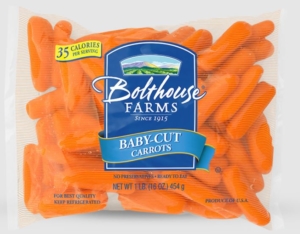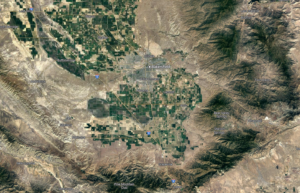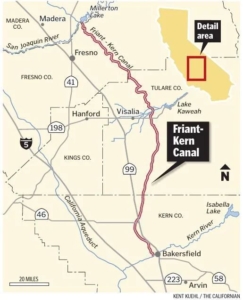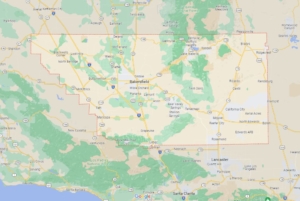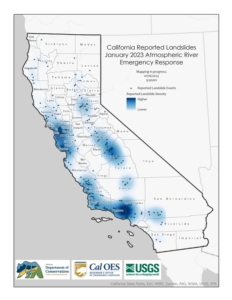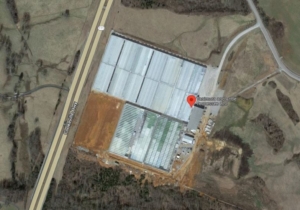[NB: check the byline, thanks./~Rayne]
You probably recognize this packaging and its contents.
Depending on the store at which you shop and location in the U.S., you might be more familiar with a different brand but similar contents.
Or perhaps you prefer regular or cooking carrots — the companies which produce them here in the U.S. are quite popular across the country.
Carrots, including “baby-style” or “baby-cut” carrots, are the fourth most popular vegetable in the U.S., with 51% of Americans surveyed acknowledging they’ve eaten them. Only potatoes, tomatoes, and onions are eaten more widely and they’re found in many dishes which aren’t potatoes, tomatoes, and onions. Carrots, though, are often eaten plain as snacks and in salads.
What’s weird about carrots for all their popularity and straightforward consumption, is how little the average American knows about them.
~ 3 ~
It’s worth your time to read this essay, Where do carrots come from? by gardening columnist Jill Severn in The Journal of Olympia, Lacey, & Tumwater (JOLT).
You may think she’ll tell where they come from, but instead she introduces you to a critical problem with and for U.S. agriculture:
Many years ago, a young woman from New York City came to visit on Bainbridge Island, brought by mutual friends who lived in Seattle. The Island amazed her; she said she had never seen so many trees.
She had also never seen a vegetable garden. As we walked the garden paths, she could identify tomatoes and cabbages, but pointed at a row of carrots and asked what they were. I pulled one up and showed her. A look of horror came over her face. “Carrots grow in the dirt?” She was horrified. “That’s so unsanitary!” Her feelings were hurt when we laughed.
Really, do go read it, because the scale and depth of the problem become more obvious. It’s not a laughing matter which Severn acknowledges.
I admit to being shocked when I first read those two grafs; I’ve had my hands in garden soil since I was eight or nine years old, growing strawberries and vegetables with the rest of my family. I know carrots not only grow in dirt but they can be a pain in the ass with the wrong soil or growing conditions, or pests. I know carrots straight out of the garden, once rinsed, are heaven to eat and need no adornment.
But as a parent I had a revelation when my oldest was tested for a gifted education program. She was encouraged not to jump into kindergarten but spend a year in a pre-K program because she didn’t know what peas were.
Admittedly, it wasn’t just peas — the other barrier was her ignorance about skipping. At age four when tested, she didn’t recognize it, didn’t know how to do it.
The one thing both peas and skipping had in common was that her parents and caregivers didn’t pass this knowledge onto her. Both parents being full-time white collar workers with schedules in excess of 40 hours a week, neither parent had spent time skipping with her. We took her to playgrounds, parks, taught her how to ride a bike with training wheels, but apparently skipping never made our agenda in the few waking hours we had together every week.
Same thing with peas, only perhaps worse: my spouse hated peas. I’d never cooked them by themselves unless as pea pods, but the test my daughter took showed her a plate with podless peas. She had no idea what they were. I wish all these years later I’d asked what she thought they were — edible beads? odd candies? alien eggs?
This is how easily Americans become ignorant, by exclusion of information. In the case of carrots and peas, they’ve become ignorant about the very foods they eat every day, and at scale about U.S. agriculture.
~ 2 ~
This is Bakersfield, California:
The grey-blueish area is the city itself, all of its residential and businesses on either side of the Kern River which bisects Kern County. The squares of different shades of green and brown to the south and north of the city are farms.
Note how the city and farms nestle in a flat area surrounded by higher uneven terrain, and how by comparison the entire area is rather arid compared to a similar-sized area in the middle-to-eastern U.S.
Kern County’s average annual rainfall is roughly 6-9 inches, depending on the source consulted; there can be wide swings in this figure from year to year as 2023 will prove. But this average rainfall figure is less than a third of that in Lansing, Michigan or Evansville, Indiana, about an eighth of that in Columbus, Ohio.
The entire county’s native plant life is chaparral – the kind of plants which thrive in a Mediterranean climate with damp cool winters and baking hot summers. Farming anything but chaparral-type plants requires more water.
Farmers have not only used as much surface water as the local ecosystem provides but pumped for more. This has destabilized areas like that beneath the Friant-Kern Canal which serves water to Kern County’s agricultural businesses.
Meanwhile, water managers on the southern end of the Friant system are watching those flows with more than a little frustration.
They are being denied the same largess because the Friant-Kern Canal is out of commission in southern Tulare County as repair work continues there to fix a “sag” along a 33-mile section caused by excessive groundwater pumping that sank the land beneath the canal.
Because of the canal repair work not scheduled for completion until 2024, increased water from this month’s storms isn’t making its way down from Friant to Kern as it would if the canal were fully operational. While rains have increased over Kern County, the groundwater isn’t being recharged if any pumping continues during or after January rains.
This is the Friant-Kern Canal’s path, diverting water from below Millerton Lake from along the base of the Sierra Nevada range to Bakersfield:
In spite of much greater rainwater received at the northern source end of the canal, drought based on technicalities – un-recharged groundwater and unfilled reservoirs — and long-term water deficits may remain at the south end.
Snow melt from the Sierra Nevada may help, but there are potential geological threats in the wake of this month’s precipitation.
This is Kern County:
To say that there may still not be enough water even after all this massive flooding is saying something. The county is the third largest in California and roughly the size of New Jersey.
I won’t even begin to address the other issues related to water quality here, including oil waste fluid and soil fumigant TCP, let alone what water stores in Kern County have meant to other parts of California south of the county.
~ 1 ~
All of which brings me back to the question Jill Severn posed: Where do carrots come from?
85% of U.S. carrot crop is produced in California.
Three of the country’s largest carrot producers — Bolthouse Farms, Grimmway Farms, and AndrewsAg — employ roughly 8000 persons in the Bakersfield area, a number close to 2% of Bakersfield’s population.
This is where our nation’s carrots come from.
Chances are good the carrot crop has been affected in some way by this month’s rainfall in California, even if Kern County hasn’t borne the brunt of it the way other portions of the state have, like central coast, or the Sierra Nevada range with its massive snow pack.
I haven’t even mentioned the challenge of transporting these carrots and other produce. You can see from the city and county maps above the highways which enter and exit Kern County, limited in part by the geography since cutting roads through hills and mountains isn’t a minor undertaking.
This map shows recent landslides which may have affected highways over which produce has been transported:
Even when the rains stop and the snow melt has finished, instability along some highways will continue.
But carrots aren’t the only produce grown in California and trucked across the U.S.
Where does our garlic comes from? Mostly Santa Clara and Fresno counties – the former badly hammered by this month’s rain – producing roughly half of all garlic consumed in the U.S.
Where do our strawberries come from? Monterey, Ventura, Santa Barbara, San Luis Obispo, and Santa Cruz counties, all along central coastal California and all savaged horribly by this month’s storms. Around 90% of strawberries consumed in the U.S. come from this region.
Lettuce is much the same as is celery. I’ve had both romaine and celery in my refrigerator recently which was grown by Tanimura & Antle Farms in California, in the San Joaquin Valley. The same valley has been flooded.
Unlike competitor Bolthouse Farms, Tanimura & Antle is an employee-owned farming business. It also owns farming operations in Arizona and Tennessee, but the latter is particularly interesting as it’s a hydroponic greenhouse facility for lettuce production located between Nashville and Knoxville.
It doesn’t look like much from the air:
But it’s much more like the most productive fresh produce farms – those in the Netherlands serving Europe.
The Washington Post ran a marvelous piece about farming in the Netherlands this past November. It’s worth the effort to read because this small country 1.5 times the size of Maryland has become a super producer, the “world’s second largest exporter of agricultural products by value behind the United States” according to the WaPo’s article.
Thinking about water and land use, we could learn a lot from the Dutch:
The Netherlands produces 4 million cows, 13 million pigs and 104 million chickens annually and is Europe’s biggest meat exporter. But it also provides vegetables to much of Western Europe. The country has nearly 24,000 acres — almost twice the size of Manhattan — of crops growing in greenhouses. These greenhouses, with less fertilizer and water, can grow in a single acre what would take 10 acres of traditional dirt farming to achieve. Dutch farms use only a half-gallon of water to grow about a pound of tomatoes, while the global average is more than 28 gallons.
How much less water would growers need in California if they used similar technologies? How much less oil would we need to ship produce if we had more smaller produce farms spread out across the U.S., copying Dutch vertical farming under LEDs in greenhouses?
How much less risk would there be to the nation’s food supply if produce wasn’t so heavily concentrated in a single state, one vulnerable to more extremes in weather, wildfire, and earthquakes?
Disruptions to power for protracted periods?
Not to mention the ongoing problems of long-term water availability and its contamination, or other challenges like food-borne illness (ex. E. coli in romaine lettuce from Salinas County, CA).
This isn’t a problem confined to California alone. The celery I bought most recently was from either California or Arizona.
The same Arizona where unincorporated municipality Rio Verde had its water supply cut off by neighboring Scottsdale due to drought. The long-term outlook doesn’t look good, either.
The heavy rain and snow battering California and other parts of the Mountain West over the past two weeks is helping to refill some reservoirs and soak dried-out soil. But water experts say that one streak of wet weather will not undo a 20-year drought that has practically emptied Lake Mead, the country’s largest reservoir, and has strained the overburdened Colorado River, which supplies about 35 percent of Arizona’s water. The rest comes from the state’s own rivers or from aquifers in the ground.
Where does our next celery come from?
We need to learn about our nation’s agriculture in a hurry.
